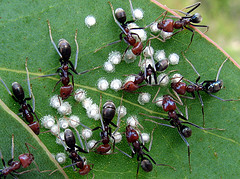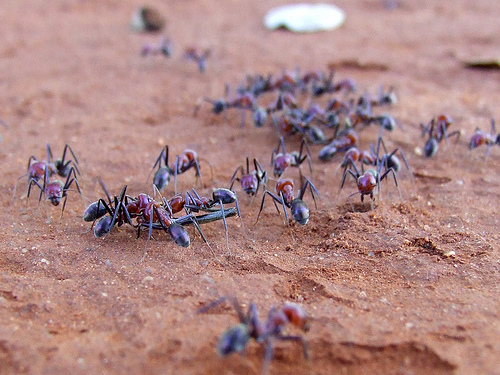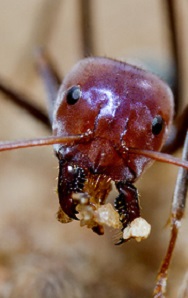References
Campbell, N.A., and J.B. Reece. 2008. Biology. Pearson/Cummings, San Francisco, California, USA.
Queensland Museum 2013. <http://www.qm.qld.gov.au/Find+out+about/Animals+of+Queensland/ Insects/Ants/Common+species/Southern+Meat+Ant>. Accessed 1 November 2013.
Australian Museum 2010. <http://australianmuseum.net.au/Meat-Ant>. Accessed 31 October 2013.
Encyclopedia of Life 2012. <http://eol.org/pages/398385/details>. Accessed 1 November 2013.
Tree of Life 2002. <http://tolweb.org/Formicidae/11247>. Accessed 1 November 2013.
Holldobler, B. and N.F. Carlin. 1985. Colony founding, queen dominance and oligogyny in the Australian meat ant Iridomyrmex purpureus. Behavioral Ecology and Sociobiology; 18(1): 45-48.
Thomas, M.L., L.J. Parry, R.A. Allan and M.A. Elgar. 1998. Geographic affinity, cuticular hydrocarbons and colony recognition in the Australian meat ant Iridomyrmex purpureus. Naturwissenschaften; 86: 87-92.
Harris, R. and J. Berry. 2013. Invasive Ant Threat. Information Sheet Number 7: Iridomyrmex pupureus. <http://www.landcareresearch.co.nz/__data/assets/pdf_file /0011/51014/7.pdf>. Accesed 1 November 2013.
Ward-Fear, G., G.P. Brown, M.J. Greenlees and R. Shine. 2009. Maladaptive traits in invasive species: in Australia, cane toads are more vulnerable to predatory ants than are native frogs. Functional Ecology; 23: 559-568.
Andersen, A.N. and A.D. Patel. 1994. Meat ants as dominant members of Australian ant communities: an experimental test of their influence on the foraging success and forager abundance of other species. Occologia; 98: 15-24.
Anderson, An. 1995. A Classification of Australian Ant Communities, Based on Functional-groups Which Parallel Plant Life-forms in Relation to Stress and Disturbance. Journal of Biogeography 22.1: 15-29. Web of Science. Accessed 13 October 2013.
Ants - Mating, Reproduction, And Life Span. Science Encylopedia.
N.p., n.d. Web. 21 Nov. 2013.
Australia. Department of the Environment. Director of National Parks. Beetles in the Gardens. By Shell Company of Australia. Australia National Botanic Gardens, n.d. Accessed 20 October 2013.
Ettershank, G., and J. A. Ettershank. 1982. Ritualized Fighting in the Meat Ant Iridomyrmex Purpureus (Smith) (Hymenoptera: Formicidae). Australian Journal of Entomology 21.2: 97-102. Wiley Online Journal. Accessed 20 October 2013.
Gibb, H., and DF Hochuli. 2004. Removal Experiment Reveals Limited Effects of a Behaviorally Dominant Species on Ant Assemblages. Ecology 85.3: 648-57. Web of Science. Accessed 10 November 2013.
Greenslade, P. J. M. 1976. The Meat Ant Iridomyrmex Purpureus (Hymenoptera Formicdae) as a Dominant Member of Ant Communities." Australia Journal of Entomology 15.2: 237-40. Wiley Online Library. Accessed 13 October 2013.
Keller, L. 1998. Queen Lifespan and Colony Characteristics in Ants and Termites. Insectes Sociaux 45.3 (n.d.): 235-46. Springer Link. Accessed 5 November 2013.
Meat Ant, Gravel Ant Fact File. Wildlife of Sydney. Australian
Museum, 2007.
Peeters, Christian, and Bert Holldobler. 1995. Reproductive Cooperation between Queens and Their Mated Workers: The Complex Life History of an Ant with a Valuable Nest. Evolution 92: 10977-0979. Proceedings of the National Academy of Sciences of the United States of America (PNAS). Accessed 13 October 2013.
Traniello, James F. A. 1989. Foraging Strategies of Ants. Annual Review of Entomology 34: 191-210. Annual Reviews. Accessed 17 October 2013.
We would like to give a special thanks to Bill and Mark Bell to whom we have credited the majority of our site media. They have been extremely helpful in our research process.


